Early Exit #19: The First 30 Days (with a new client)
6 pro-tips from other marketing freelancers (and me!)
You’re reading Early Exit Club — a newsletter about leaving the 9-5 workforce to build a $20k/month solo business by Nick Lafferty.
Howdy from breezy South Padre Island in the southeastern most part of Texas. I have a few more trips planned to end the year strong because one of the things we sacrificed at the start of my Early Exit journey was vacations and now it’s time to make up for it 😎
Some fun updates from the last few weeks:
I was on my pal Rachel Meltzer’s podcast. She’s a brilliant freelance writer and founder of Camp Moxie, a bootcamp for aspiring freelance writers. I dropped a teaser for where my wife and I are trying to move next year 👀
I’ve hired someone to help me post on LinkedIn (more on this in a future newsletter).
I launched a digital product, a proven growth marketing playbook to use your competitor’s strengths against them.
My other pal Rachel Shi (so many Rachel’s!) launched a pre-sale for her course for sales pros on how to crush your Q4. Rachel is the top AE at Metadata and her course is currently 75% off ‼️
Last week I asked my friends on LinkedIn how they approach the first 30 days with a new client and today I’ll share their experiences alongside my own.
Next week I’ll rewind the clock to talk about my first 30 days as a freelancer to unpack what I did right (a few things) and what I did wrong (many things.
Your First 30 Days With a New Client
Nearly all of my consulting clients are new this year so I had many opportunities to start the first 30 days on the right foot.
But one of my new goals is to add more perspectives to this newsletter besides my own. I’ve met so many talented freelancers and solopreneurs in the last few months that it would be a shame not to include their experience too.
Here’s the summary in bullet point form, scroll down for more info on each one.
Expectations are everything
Start with an audit or workshop
Reduce time to value
Understand your client’s ideal customer
Get a quick win
Work with urgency
Expectations are everything
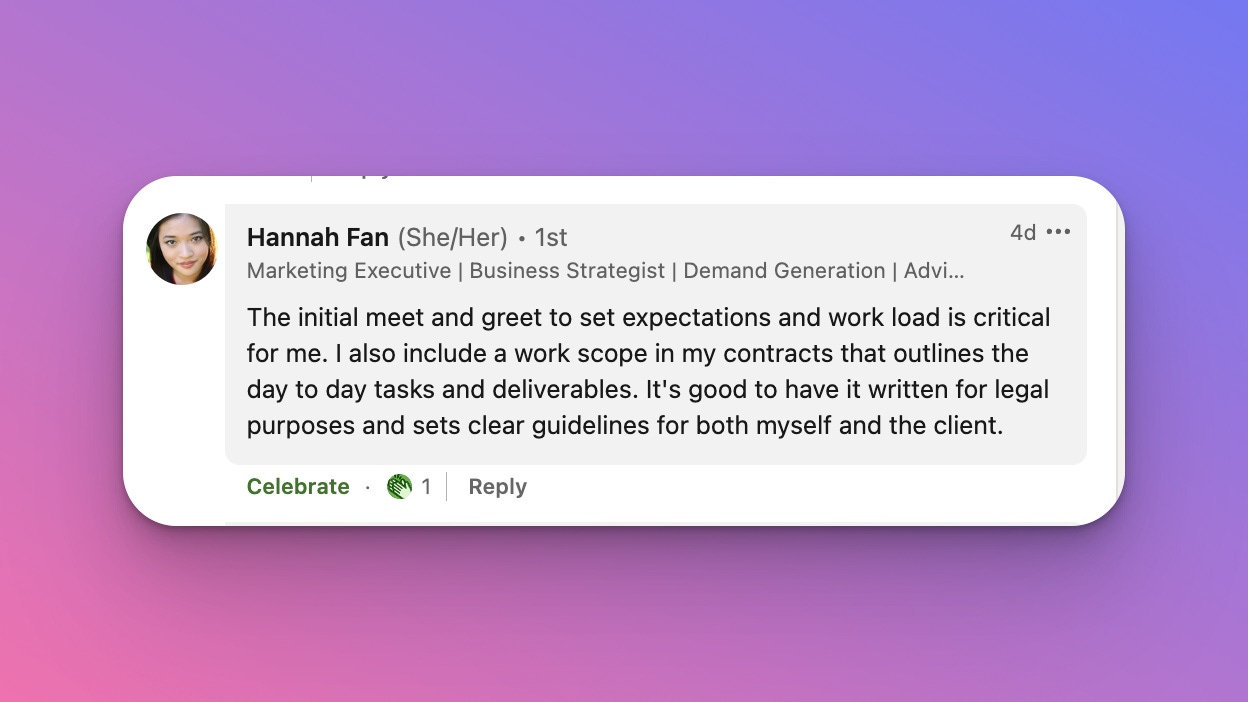
If I were to build my Mount Rushmore of tips of new freelancers, this would be in it.
Set expectations before starting work. Your client should know both what they’re getting and what they’re not getting.
I am super clear with my clients that I don’t do Facebook ads. There is no confusion here, I use direct language with no ambiguity.
This saves me time and hassle down the road (I really don’t want to run Facebook ads) and helps the client calibrate what is realistic to ask for.
Takeaway tip: Clearly define work that is in scope and out of scope. If you get requests outside of scope then gently remind the client of that.
Start with an audit or workshop
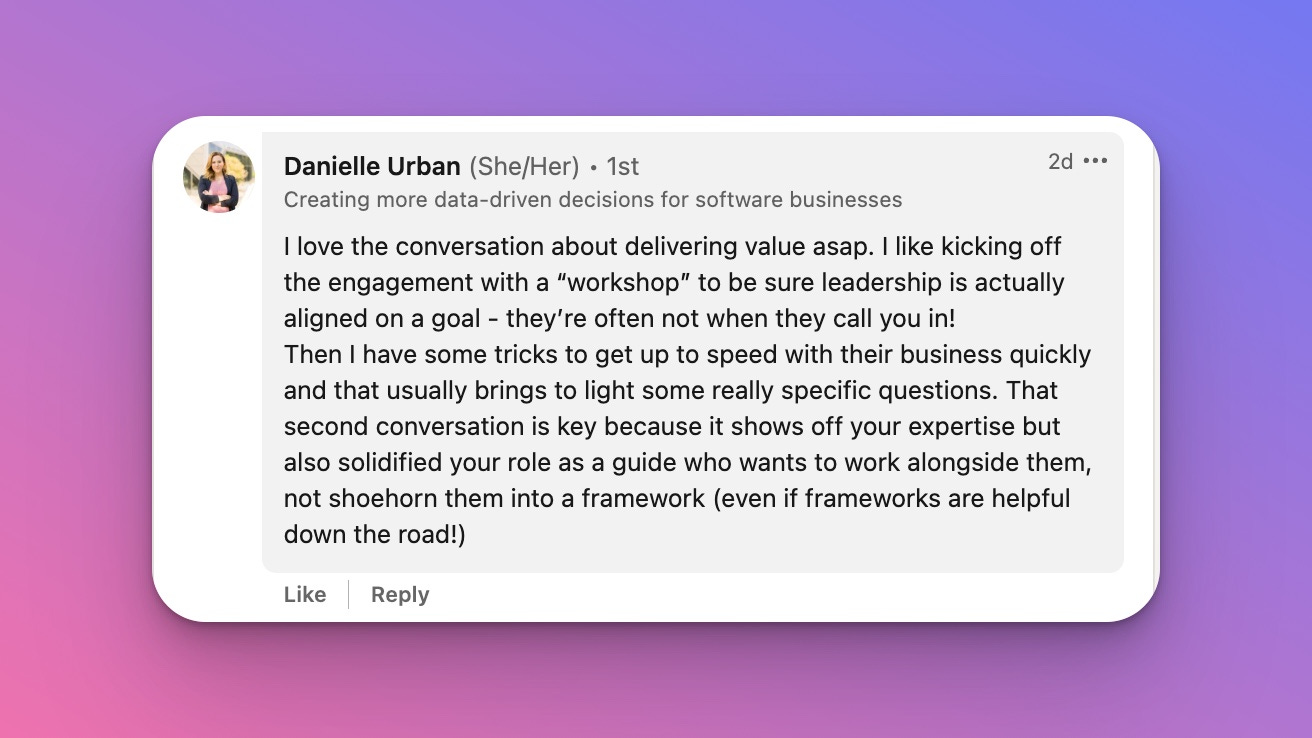
My consulting engagements are often focused on paid ads so my first step is to audit what’s been done before me.
Using my experience I determine what’s working, what isn’t, and what our best path forward is.
This often takes me about a week and I deliver it in a Notion document. The outcome of the audit informs the next few months of work in a prioritized list based on impact.
But this isn’t limited to paid ads. I’ve personally seen it done for:
SEO
Marketing operations
Demand gen
Advising
My audit presentations often double as workshops where I’m trying to get additional information and context from my client (why was it done this way before?).
Danielle’s tip here about running a workshop is a great way to pull information from your client that will help you be more effective in your consulting role.
Takeaway tip: As much as I love Loom, sometimes you really do need a meeting. Use the early momentum when your consulting engagement is new to get the right decision makers in a meeting together.
Reduce time to value
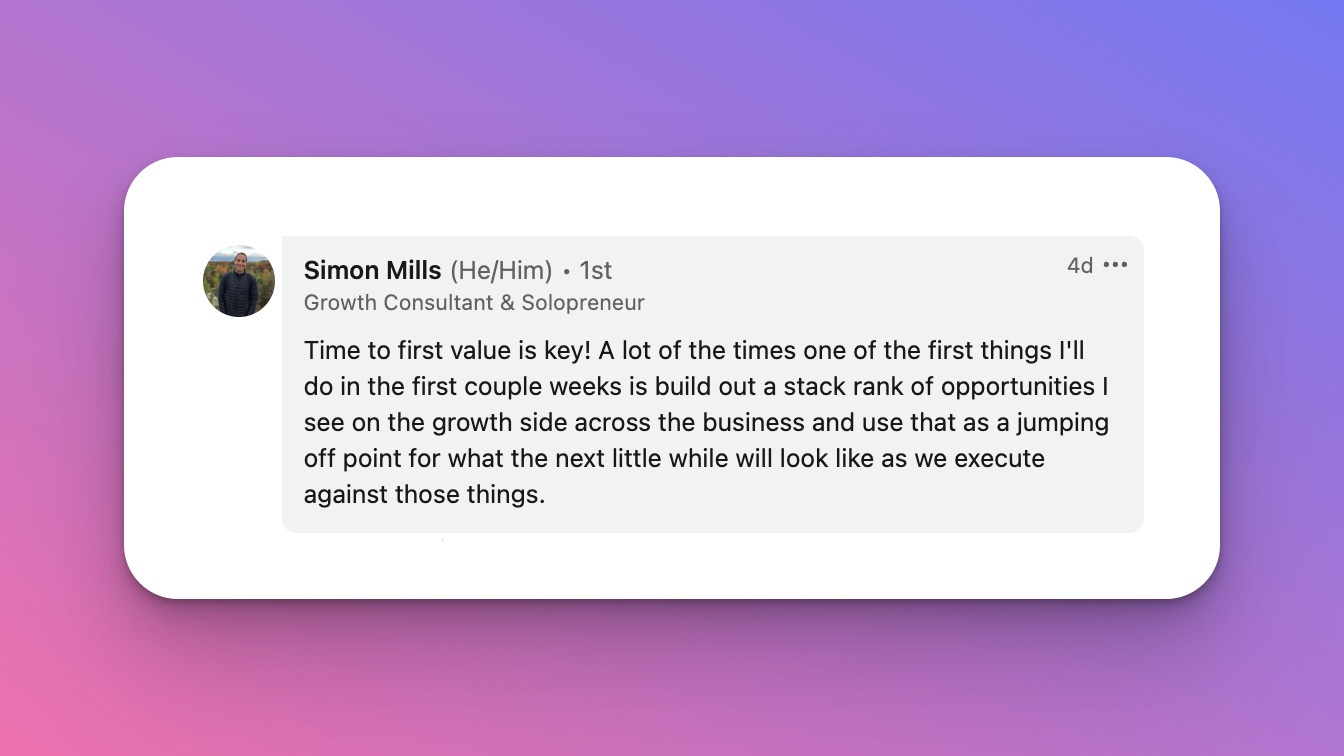
Simon’s advice here is something I index on with all of my clients and it’s one of the best ways to quickly make an impact.
Every single client has a bunch of opportunities laying on the floor, it just takes someone to pick them up and run with them.
Use your experience to determine what’s worth doing right now to give your longer term projects some momentum.
The faster you can deliver something the better.
Takeaway tip: Time is money and every single company has low hanging fruit you can capture and fix to build trust.
Product of the Week
Harlow helps freelancers get organized, save time, and look professional with automated invoicing, proposal templates, and much more—all from one centralized hub.
Their newsletter tackles the most important topics facing the freelance community. They strive to make sure every newsletter focuses on what matters – whether that’s planning for an upcoming recession or figuring out how to get paid on time. Subscribe now and join the thousands of other freelancers who are tuning in.
Understand your client’s ideal customer
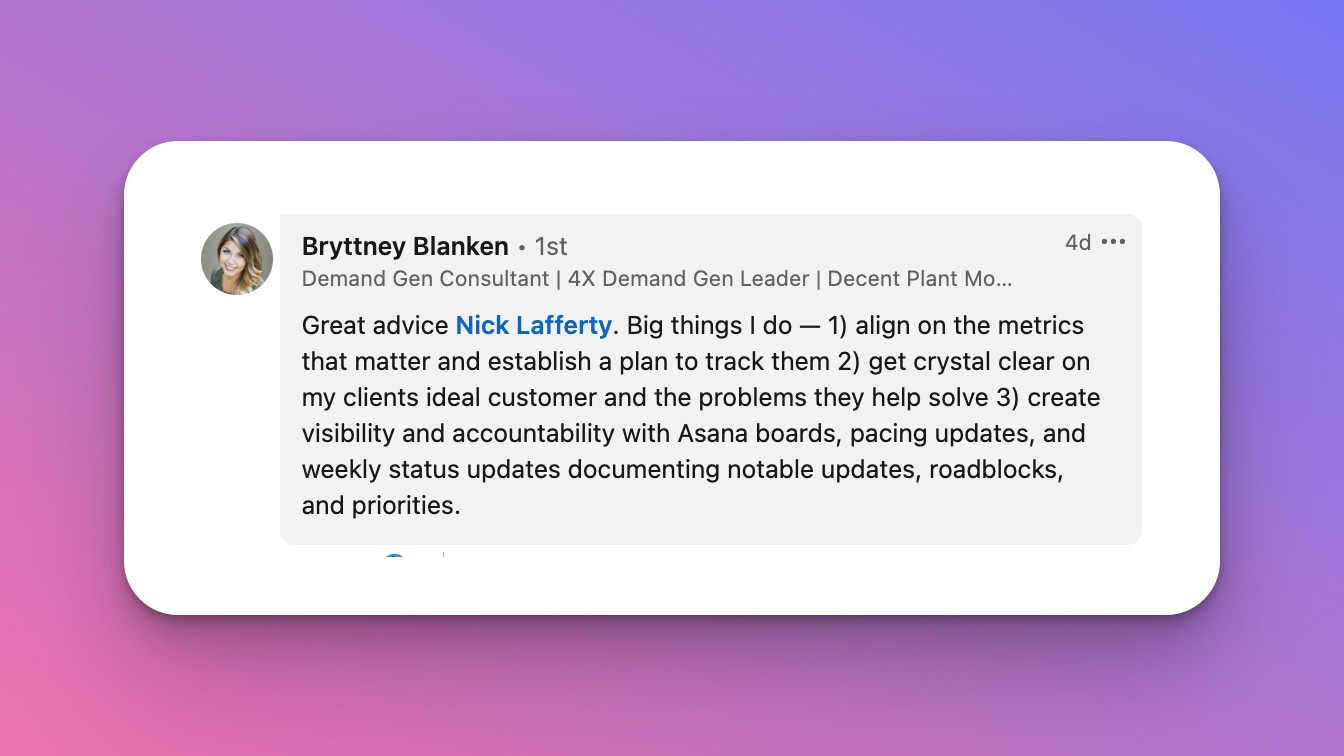
It was hard to choose between the 3 tips Bryttney gave here but I decided to use this one because it’s so easy to skip.
Understanding your client’s ideal customer helps refine your lens on what you prioritize and it helps you be more effective in your job.
In my consulting business I make it a point to learn my client’s business.
I want to be able to speak as if I were a full time employee.
I want to know the lingo, the ideal customers, and how their product works.
It helps me make better decisions and it helps build trust with my clients too.
Takeaway tip: Spend time up front to understand your clients ideal customer. Ask who is and isn’t their ideal customer and why. Write them down to reference later.
Get a quick win
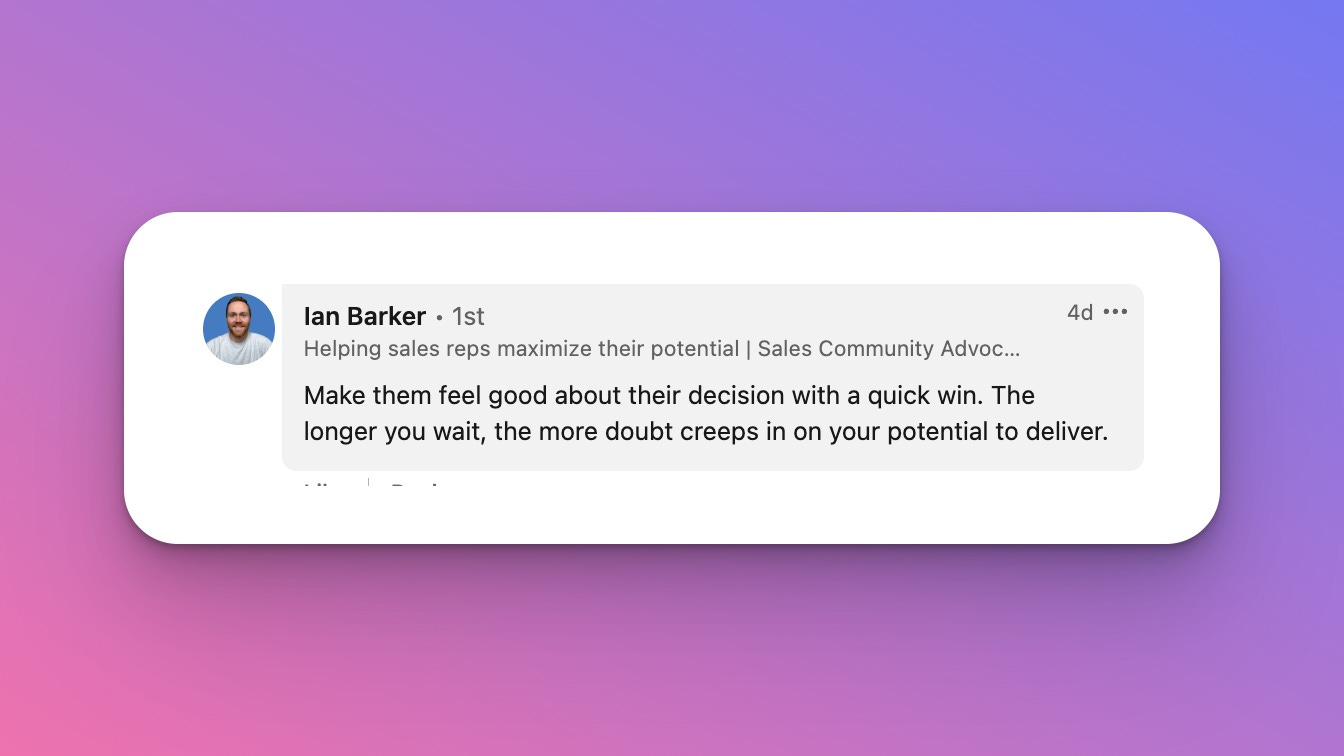
I try to get a quick win within the first two weeks, or within the first month at the very latest.
Building trust and confidence is an important part of all my consulting engagements.
These people are paying good money for my time and experience and I want to make sure I’ve delivered on something before that first invoice hits.
Takeaway tip: Identify a problem you can fix within the first 30 days, fix it, and let your client know.
Work with urgency
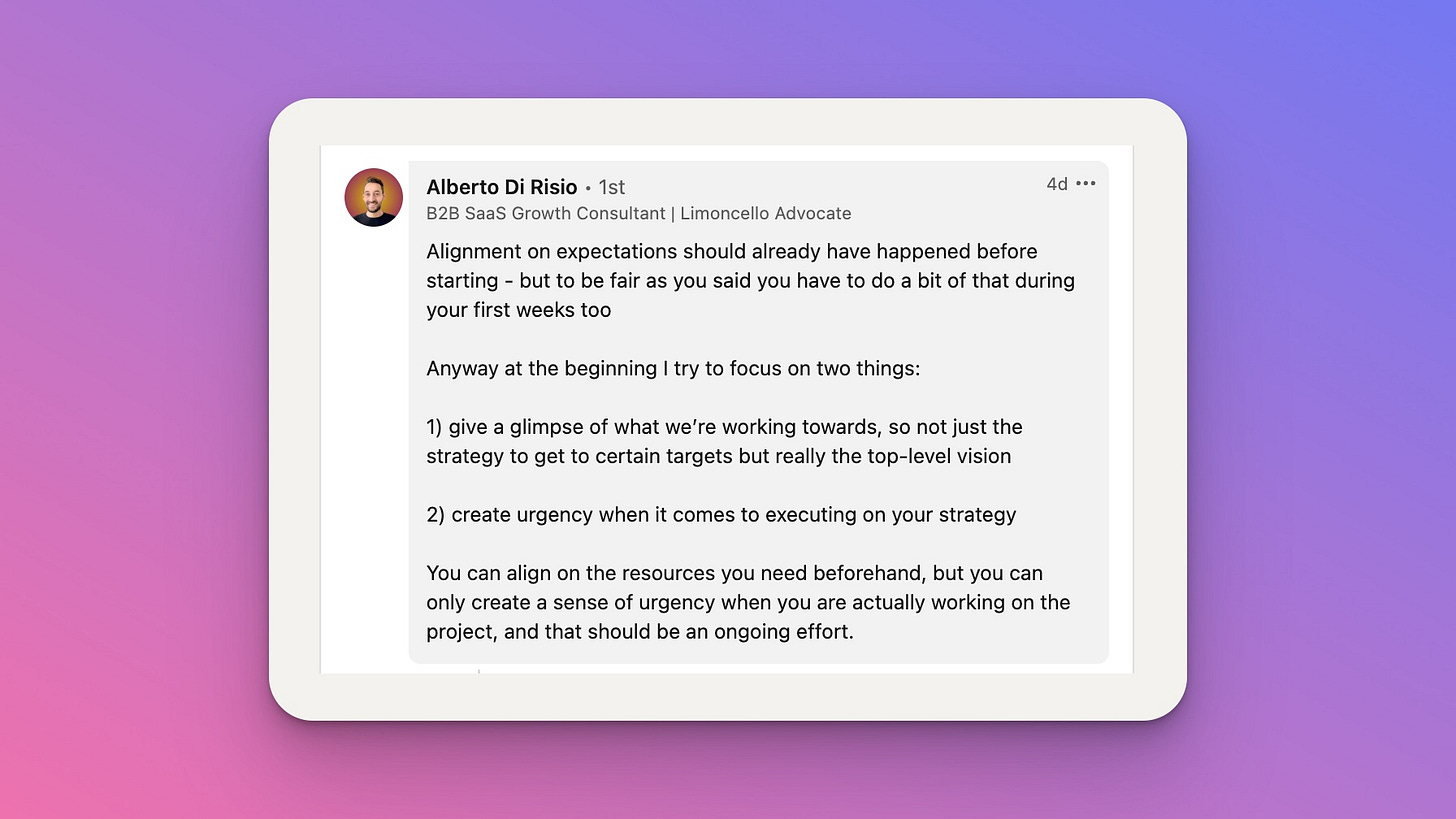
This tip from Alberto goes hand in hand with the previous quick win tip but it goes beyond the first 30 days.
Part of my value is that I work with speed and urgency. I’m available on slack during business hours and if my client needs something fixed I can hop in and often do it right away.
That’s not always the case and there’s an argument to be made that you shouldn’t make yourself too available (after all you’re not a full-time employee), so to me this goes back to tip #1 of setting the right expectations.
Build visibility into what’s getting worked on when and communicate as you check things off the list.
Takeaway tip: Your client is paying for results and they want to know their money is well spent. Working with urgency helps deliver that trust alongside moving projects forward.
Did I miss anything?
Reply with your tips and I’ll edit this post with the best ones!
My honest goal with this newsletter is to incorporate other voices and I’m not shy about giving credit (and recognizing my own knowledge gaps).
See you all next week for a 6-month retrospective on my first 30 days of consulting and all the mistakes I made!
Nick
Did someone send this to you? First, tell them thanks. Second, maybe you should subscribe too?







Love these tips! Especially the quick win one!